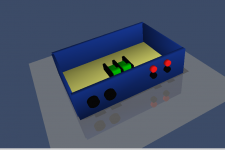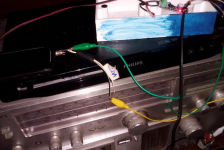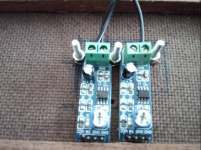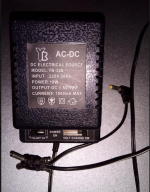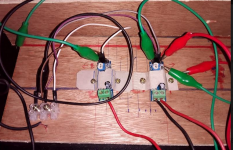Batteries Included?
Let's see:
Understanding Battery Configurations | Battery Stuff
OK. So the if we use 6 D size batteries of 8000 mAh capacity, we can draw 300 mA for 8000/300 = 26 hours.
There is also a system that runs off 96 batteries, and sounds better to boot.
Audio Ecstasy With Battery Power- The Final (Labs) Frontier by Steven R. Rochlin
Using rechargeable batteries will improve things a great deal, so with rechargeable batteries running will last about 50 times longer, that is 120 days if run for 24 hours at a stretch. In fact, many of the Bluetooth mono low fi speakers run off rechargeable batteries and can keep their power for some time. There is one I have been using for more than 2 years.
Let's see:
How to wire batteries in series: Connecting batteries in series adds the voltage of the two batteries, but it keeps the same amperage rating (also known as Amp Hours). For example, these two 6-volt batteries joined in series now produce 12 volts, but they still have a total capacity of 10 amps.
Understanding Battery Configurations | Battery Stuff
OK. So the if we use 6 D size batteries of 8000 mAh capacity, we can draw 300 mA for 8000/300 = 26 hours.
There is also a system that runs off 96 batteries, and sounds better to boot.
Audio Ecstasy With Battery Power- The Final (Labs) Frontier by Steven R. Rochlin
Using rechargeable batteries will improve things a great deal, so with rechargeable batteries running will last about 50 times longer, that is 120 days if run for 24 hours at a stretch. In fact, many of the Bluetooth mono low fi speakers run off rechargeable batteries and can keep their power for some time. There is one I have been using for more than 2 years.
If I power it off batteries, how long will it last? 300 mA current draw X 2 is 600 mA. A typical AA battery will be rated at 1100 mAh so this means 1 3 hours run time? 9V will require 6 batteries so that means a total of 6000 mAh?
Hi
this is not correct !
1 battery has 1,5V and 600mAh capacity - so if you need 9V you have to use 6 batteries in series. one battery after the other - so it is a chain --> so the weakest battery gives you the max running time.
chris
Let's see:
Understanding Battery Configurations | Battery Stuff
OK. So the if we use 6 D size batteries of 8000 mAh capacity, we can draw 300 mA for 8000/300 = 26 hours.
There is also a system that runs off 96 batteries, and sounds better to boot.
Audio Ecstasy With Battery Power- The Final (Labs) Frontier by Steven R. Rochlin
Using rechargeable batteries will improve things a great deal, so with rechargeable batteries running will last about 50 times longer, that is 120 days if run for 24 hours at a stretch. In fact, many of the Bluetooth mono low fi speakers run off rechargeable batteries and can keep their power for some time. There is one I have been using for more than 2 years.
Hi
If i understand you correct you want to do this small amp with 9V power supply for your LM386 with rechargeable/changeable batteries.
choose a 9V block battery holder. 9V battery has about 600mAh and if you use 2 batteries in parallel then you get about 4 hours listening time. i think its enough for that little amp.
chris
Why go for 4 hours when you can have 12,000 mAh with an alkaline D size (ok need 6 of them) and run for 12,000 / 300 mA for 40 hours. Actually I measured much less current draw about 100 mA at 75% volume. Should be interesting, a portable amplifier that will run for 120 hours.
The LM386 was MADE for pocket radios using 9V battery. Battery like will be "sufficient".
Before LM386, I was powering "9V" pocket transistor radios with "dead" 6V *lantern* batteries, about 3 pounds. While hardly "pocket", this would run for a month non-stop, many months evenings-only.
Before LM386, I was powering "9V" pocket transistor radios with "dead" 6V *lantern* batteries, about 3 pounds. While hardly "pocket", this would run for a month non-stop, many months evenings-only.
Testing the LM
Restarted the project and hooked it up to the large, SONY SS 333 speakers for testing.
How did it sound? Well, on the minus side, the amplifier was somewhat out of its league, with a less than dynamic upper and mid range. It seemed to lack the power to drive the large speakers. Source is an old HTC Explorer used as an MP3 player with mp3s downloaded via a paid subscription from Hungama.
On the plus side, bass was good and clean, and vocals were well produced, portraying emotion in vocals well. This was with only one side hooked up.
I sit here thinking: 20 year old speakers with a amplifier that costs less than a dollar, powered by a 9 Volt battery, putting out so much music. What is the meaning of all this? I cannot fathom.
So I hope to complete the amp and even hook it up to a CD player.
Restarted the project and hooked it up to the large, SONY SS 333 speakers for testing.
How did it sound? Well, on the minus side, the amplifier was somewhat out of its league, with a less than dynamic upper and mid range. It seemed to lack the power to drive the large speakers. Source is an old HTC Explorer used as an MP3 player with mp3s downloaded via a paid subscription from Hungama.
On the plus side, bass was good and clean, and vocals were well produced, portraying emotion in vocals well. This was with only one side hooked up.
I sit here thinking: 20 year old speakers with a amplifier that costs less than a dollar, powered by a 9 Volt battery, putting out so much music. What is the meaning of all this? I cannot fathom.
So I hope to complete the amp and even hook it up to a CD player.
Attachments
Last edited:
Two boards installed - Power?
I managed to fix the boards in place though there are no mounting points. How do I connect the power? 9V connected to the VCC of one board, and out from the GND to the VCC of the other board, then GND to negative? It does not work probably because of under voltage.
So do I connect 10 V or 12 V the following way? Should work but need to be double sure.
12V + to VCC Board 1
GND Board 1 to VCC Board 2
GND Board 2 to -12V
Sorry for the blurred pictures. Also, if anyone has any suggestions on how to mount the boards please let me know.
I managed to fix the boards in place though there are no mounting points. How do I connect the power? 9V connected to the VCC of one board, and out from the GND to the VCC of the other board, then GND to negative? It does not work probably because of under voltage.
So do I connect 10 V or 12 V the following way? Should work but need to be double sure.
12V + to VCC Board 1
GND Board 1 to VCC Board 2
GND Board 2 to -12V
Sorry for the blurred pictures. Also, if anyone has any suggestions on how to mount the boards please let me know.
Attachments
Testing: Using a 12V power supply across both the boards worked, sort of. At 9V there was a distorted noise output from the speakers, at 12V there was an initial squeal on powering on, and the sound after that was lower in volume and distorted. 6V per side is not going to do it.
Measurements of power draw for one channel was 10 mA without sound input and upto 20 mA with an input from the sound source. So both channels will draw 40 mA or so total. Which leads me to wonder if a parallel power connection will fix the problem, instead of connecting 12V across both boards, split the power supply into two wires and connect each set of wires to the respective inputs of the boards. The large adapter I have is rated at 1000 mA so that should not be a problem. Any suggestions?
Measurements of power draw for one channel was 10 mA without sound input and upto 20 mA with an input from the sound source. So both channels will draw 40 mA or so total. Which leads me to wonder if a parallel power connection will fix the problem, instead of connecting 12V across both boards, split the power supply into two wires and connect each set of wires to the respective inputs of the boards. The large adapter I have is rated at 1000 mA so that should not be a problem. Any suggestions?
Testing with 12 adapter
Testing with a variable voltage 3-12V adapter was successful. If there is any distortion I could always turn down the gain on the boards. This is good because the 9V batteries are now down to about 7.5 and 8.5 V and at 7.5 V there is a lot of unacceptable distortion at 8.5 the sound is clear. Ideally 16V would do it, but to be fair the chip does not use up a lot of current and does not get heated up.
Testing with a variable voltage 3-12V adapter was successful. If there is any distortion I could always turn down the gain on the boards. This is good because the 9V batteries are now down to about 7.5 and 8.5 V and at 7.5 V there is a lot of unacceptable distortion at 8.5 the sound is clear. Ideally 16V would do it, but to be fair the chip does not use up a lot of current and does not get heated up.
Attachments
I did some further testing with two 9V batteries and also with the AC/DC adapter shown in the picture.
The LM386 board works fine with 9V supplied to one side, or 9V supplied to both sides side individually. Using the adapter pictured, I was able to connect to both power inputs in parallel, but there was a lot of distortion during music peaks, the sound was clearly distorted. Adjusting the gain on the board did little to solve the problem.
I had noticed a reduction in sound quality as one of the batteries was around 7.5V as opposed to 8.5 V on the other battery that explained a worrying drop in sound quality I had noticed. After all this work, if sound quality was not up to par that is a real shame. That is sorted out.
Measuring the voltage across the DC input terminals gave some surprising results. The adapter marked at 1.5 to 12 V
was giving out 18V at the maximum, reducing the voltage brought the measured voltage down to 5V. The adapter can power one channel down to 5V albeit with noticeable distortion. So the problem seems to be the peak current draw in any case 20 mA. I could use two independent adapters. With the specification sheet listing 4V minimum for the LM 386, it is possible to run this system using this low voltage.
The other possibility is to use an input capacitor which can store a temporary store of energy for the amplifier. Is this why some amplifiers use large capacitors in the power supply? A standard LM 386 circuit should have a suggestion.
This is such an interesting project. I guess it shows the need for a proper power supply for an amplifier circuit, and that it affects sound quality. The LM386 is a really nice sounding amplifier if the spec sheet is to be believed, all of the distortion is above 20 kHz. Listening tests back this up, real nice sound from this thing under the right circumstances.
All with 300mW per side.
** Note: I apologize for the strange formatting caused by cutting and pasting from a text editor.
The LM386 board works fine with 9V supplied to one side, or 9V supplied to both sides side individually. Using the adapter pictured, I was able to connect to both power inputs in parallel, but there was a lot of distortion during music peaks, the sound was clearly distorted. Adjusting the gain on the board did little to solve the problem.
I had noticed a reduction in sound quality as one of the batteries was around 7.5V as opposed to 8.5 V on the other battery that explained a worrying drop in sound quality I had noticed. After all this work, if sound quality was not up to par that is a real shame. That is sorted out.
Measuring the voltage across the DC input terminals gave some surprising results. The adapter marked at 1.5 to 12 V
was giving out 18V at the maximum, reducing the voltage brought the measured voltage down to 5V. The adapter can power one channel down to 5V albeit with noticeable distortion. So the problem seems to be the peak current draw in any case 20 mA. I could use two independent adapters. With the specification sheet listing 4V minimum for the LM 386, it is possible to run this system using this low voltage.
The other possibility is to use an input capacitor which can store a temporary store of energy for the amplifier. Is this why some amplifiers use large capacitors in the power supply? A standard LM 386 circuit should have a suggestion.
This is such an interesting project. I guess it shows the need for a proper power supply for an amplifier circuit, and that it affects sound quality. The LM386 is a really nice sounding amplifier if the spec sheet is to be believed, all of the distortion is above 20 kHz. Listening tests back this up, real nice sound from this thing under the right circumstances.
All with 300mW per side.
** Note: I apologize for the strange formatting caused by cutting and pasting from a text editor.
Tested and it works fine, plays loud with some fluidity of dynamics. The secret is the input voltage, listed as 5-12V, I have a 9V adapter for one channel and a 9V battery showing 8.5 V on the other. The adapter driven channel (adapter shown above) generates a nice hum that disappears when the music is on.
This will be then a dual power supply amplifier - powered by two 9V adapters, no on/off switch and no volume controls. Dual on/offs and volume controls are simply too much. A bass enhancement circuit may be in the offing.
This will be then a dual power supply amplifier - powered by two 9V adapters, no on/off switch and no volume controls. Dual on/offs and volume controls are simply too much. A bass enhancement circuit may be in the offing.
Last edited:
Connecting up the old DVD/CD player resulted in some great listening sessions. The power of course was not there to produce the dynamics I would have liked, but the mid range again was clear and smooth. I listened to Peter Gabriels "SO" album as well as a Vinyl to CD conversion of "After Dark" by Andy Gibb. The voices were particularly expressive and the entire sound was 'engaging' as they say. A great stop gap amplifier while my other amplifiers are being completed.
Connections internally were all crimped connections and all of them loosely plugged in to the connectors. The big let down was the RC cable which seemed to be frayed inside and produced an intermittent fault. I need to complete this soon in some form or another and move on.
Connections internally were all crimped connections and all of them loosely plugged in to the connectors. The big let down was the RC cable which seemed to be frayed inside and produced an intermittent fault. I need to complete this soon in some form or another and move on.
- Home
- Amplifiers
- Chip Amps
- Dual LM 386 board based amplifier project
